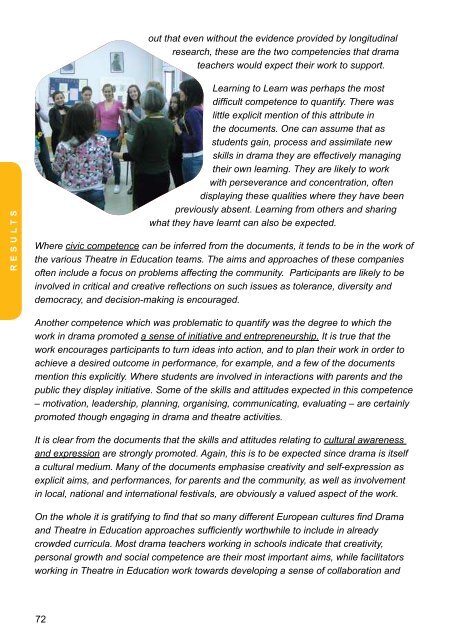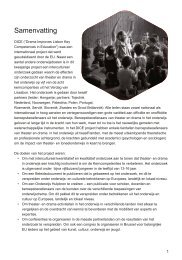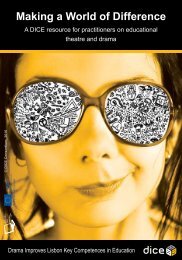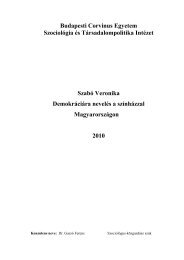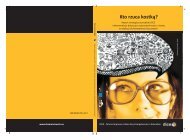Policy Paper - Drama Improves Lisbon Key Competences in Education
Policy Paper - Drama Improves Lisbon Key Competences in Education
Policy Paper - Drama Improves Lisbon Key Competences in Education
You also want an ePaper? Increase the reach of your titles
YUMPU automatically turns print PDFs into web optimized ePapers that Google loves.
R e s u l t s<br />
out that even without the evidence provided by longitud<strong>in</strong>al<br />
research, these are the two competencies that drama<br />
teachers would expect their work to support.<br />
Learn<strong>in</strong>g to Learn was perhaps the most<br />
difficult competence to quantify. There was<br />
little explicit mention of this attribute <strong>in</strong><br />
the documents. One can assume that as<br />
students ga<strong>in</strong>, process and assimilate new<br />
skills <strong>in</strong> drama they are effectively manag<strong>in</strong>g<br />
their own learn<strong>in</strong>g. They are likely to work<br />
with perseverance and concentration, often<br />
display<strong>in</strong>g these qualities where they have been<br />
previously absent. Learn<strong>in</strong>g from others and shar<strong>in</strong>g<br />
what they have learnt can also be expected.<br />
Where civic competence can be <strong>in</strong>ferred from the documents, it tends to be <strong>in</strong> the work of<br />
the various Theatre <strong>in</strong> <strong>Education</strong> teams. The aims and approaches of these companies<br />
often <strong>in</strong>clude a focus on problems affect<strong>in</strong>g the community. Participants are likely to be<br />
<strong>in</strong>volved <strong>in</strong> critical and creative reflections on such issues as tolerance, diversity and<br />
democracy, and decision-mak<strong>in</strong>g is encouraged.<br />
Another competence which was problematic to quantify was the degree to which the<br />
work <strong>in</strong> drama promoted a sense of <strong>in</strong>itiative and entrepreneurship. It is true that the<br />
work encourages participants to turn ideas <strong>in</strong>to action, and to plan their work <strong>in</strong> order to<br />
achieve a desired outcome <strong>in</strong> performance, for example, and a few of the documents<br />
mention this explicitly. Where students are <strong>in</strong>volved <strong>in</strong> <strong>in</strong>teractions with parents and the<br />
public they display <strong>in</strong>itiative. Some of the skills and attitudes expected <strong>in</strong> this competence<br />
– motivation, leadership, plann<strong>in</strong>g, organis<strong>in</strong>g, communicat<strong>in</strong>g, evaluat<strong>in</strong>g – are certa<strong>in</strong>ly<br />
promoted though engag<strong>in</strong>g <strong>in</strong> drama and theatre activities.<br />
It is clear from the documents that the skills and attitudes relat<strong>in</strong>g to cultural awareness<br />
and expression are strongly promoted. Aga<strong>in</strong>, this is to be expected s<strong>in</strong>ce drama is itself<br />
a cultural medium. Many of the documents emphasise creativity and self-expression as<br />
explicit aims, and performances, for parents and the community, as well as <strong>in</strong>volvement<br />
<strong>in</strong> local, national and <strong>in</strong>ternational festivals, are obviously a valued aspect of the work.<br />
responsibility <strong>in</strong> the participants. The aim of creat<strong>in</strong>g an artistic work did not always<br />
feature as the most important objective.<br />
It it is very hearten<strong>in</strong>g to f<strong>in</strong>d that teachers and facilitators throughout Europe and beyond<br />
are us<strong>in</strong>g drama and theatre approaches to animate their classrooms, to promote<br />
creativity and imag<strong>in</strong>ation, to encourage personal and social transformations and to give<br />
their students a sense of power, responsibility and ownership with<strong>in</strong> the work.<br />
B.11. Relationships between the different<br />
components of the quantitative research, and an<br />
example: what makes an educational theatre and<br />
drama programme better?<br />
This chapter tries to expla<strong>in</strong> what makes the DICE research design special and why we<br />
say that all the results above are less than 1% of all the results of the research.<br />
Until this po<strong>in</strong>t we have been discuss<strong>in</strong>g the different parts of the research separately.<br />
Now imag<strong>in</strong>e that all of the quantitative tools discussed above are <strong>in</strong>terl<strong>in</strong>ked and their<br />
relationships can be exam<strong>in</strong>ed, so that you can look at the relationships between any<br />
parts of:<br />
• the students’ self assessment questionnaires,<br />
• the teachers’ questionnaires,<br />
• the drama descriptions,<br />
• the observations,<br />
• and the external assessments.<br />
So two examples: it is possible to exam<strong>in</strong>e whether those programmes that have been<br />
assessed highly (external assessment) and are small group work dom<strong>in</strong>ant (observation)<br />
have a greater impact on students’ communication skills (students’ questionnaires),<br />
or not. Or, we can see whether or not those students who have not participated <strong>in</strong><br />
any drama activity before (students’ questionnaire) are assessed more highly by their<br />
teachers (teachers’ questionnaire) after they have participated <strong>in</strong> a series of youth theatre<br />
workshops (drama description).<br />
R e s u l t s<br />
On the whole it is gratify<strong>in</strong>g to f<strong>in</strong>d that so many different European cultures f<strong>in</strong>d <strong>Drama</strong><br />
and Theatre <strong>in</strong> <strong>Education</strong> approaches sufficiently worthwhile to <strong>in</strong>clude <strong>in</strong> already<br />
crowded curricula. Most drama teachers work<strong>in</strong>g <strong>in</strong> schools <strong>in</strong>dicate that creativity,<br />
personal growth and social competence are their most important aims, while facilitators<br />
work<strong>in</strong>g <strong>in</strong> Theatre <strong>in</strong> <strong>Education</strong> work towards develop<strong>in</strong>g a sense of collaboration and<br />
In addition, the same analyses can be run on any subset of the entire sample, e.g. only<br />
Polish students, or only girls, or only those go<strong>in</strong>g to a special school, or only 14-year-old<br />
students, or even only those 14-year-old Polish girls who go to a special school!<br />
Given that there are 1,080 variables measured per student, all of them <strong>in</strong>terl<strong>in</strong>ked, and<br />
given that the sample is uniquely large and rich, there are almost endless possibilities<br />
72<br />
73


